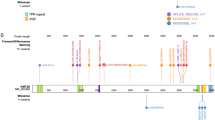Abstract
Purpose
A 42-year-old man with hyper-IgM syndrome type 2 caused by activation-induced cytidine deaminase (AID) deficiency developed a severe anaphylactic reaction to intravenous immunoglobulin. The purpose of this study was to clarify the cause of the anaphylactic reaction of the patient.
Methods
We measured IgM-class anti-human IgG and anti-human IgA antibodies in his serum by sandwich enzyme-linked immunosorbent assay (ELISA).
Results
The sandwich ELISA assay revealed that serum from the patient, but not the controls, reacted to three different IgG products and purified human IgA. This indicated that the patient had IgM-class anti-human IgG and IgA antibodies in his serum, which associated with the anaphylactic reactions after the administration of IgG products. The anti-IgG antibody was likely to be the main cause of the reactions because an IgA-depleted IgG product also induced a severe reaction in this case and showed high absorbance in the ELISA system, similar to other IgG products containing more IgA.
Conclusions
This is the first report of IgM-class anti-human IgG associated with an anaphylactic reaction to an IgG infusion. The anaphylactic reactions were very severe in this case, probably because IgM-class antibodies are potent activators of the complement pathway.

Similar content being viewed by others
References
Orange JS, Hossny EM, Weiler CR, et al. Use of intravenous immunoglobulin in human disease: a review of evidence by members of the Primary Immunodeficiency Committee of the American Academy of Allergy, Asthma and Immunology. J Allergy Clin Immunol. 2006;117(4 Suppl):S525–53. https://doi.org/10.1016/j.jaci.2006.01.015.
Eijkhout HW, van Der Meer JW, Kallenberg CG, et al. The effect of two different dosages of intravenous immunoglobulin on the incidence of recurrent infections in patients with primary hypogammaglobulinemia. A randomized, double-blind, multicenter crossover trial. Ann Intern Med. 2001;135(3):165–74. https://doi.org/10.7326/0003-4819-135-3-200108070-00008.
Wells JV, Buckley RH, Schanfield MS, Fundenberg HH. Anaphylactic reactions to plasma infusions in patients with hypogammaglobulinemia and anti-IgA antibodies. Clin Immunol Immunopathol. 1977;8(2):265–71. https://doi.org/10.1016/0090-1229(77)90116-7.
Vyas GN, Perkins HA, Fudenberg HH. Anaphylactoid transfusion reactions associated with anti-IgA. Lancet. 1968;2(7563):312–5.
Sandler SG, Mallory D, Malamut D, Eckrich R. IgA anaphylactic transfusion reactions. Transfus Med Rev. 1995;9(1):1–8. https://doi.org/10.1016/S0887-7963(05)80026-4.
Burks AW, Sampson HA, Buckley RH. Anaphylactic reactions after gamma globulin administration in patients with hypogammaglobulinemia. Detection of IgE antibodies to IgA. N Engl J Med. 1986;314(9):560–4. https://doi.org/10.1056/NEJM198602273140907.
Kitamura K, Mikami Y. Analysis of the physicochemical and biochemical property of various intravenous immunoglonbulin preparations. Biotherapy. 2002;16:467–76. (Article in Japanese)
Ochs HD, Smith CIE, Puck JM. Primary immunodeficiency diseases. A molecular and genetic approach. Third edition, NY, USA, 2014. p. 299–365.
Revy P, Muto T, Levy Y, Geissmann F, Plebani A, Sanal O, et al. Activation-induced cytidine deaminase (AID) deficiency causes the autosomal recessive form of the hyper-IgM syndrome (HIGM2). Cell. 2000;102(5):565–75. https://doi.org/10.1016/S0092-8674(00)00079-9.
Fabry U, Körholz D, Jürgens H, Göbel U, Wahn V. Anaphylaxis to L-asparaginase during treatment for acute lymphoblastic leukemia in children—evidence of a complement-mediated mechanism. Pediatr Res. 1985;19(4):400–8. https://doi.org/10.1203/00006450-198519040-00017.
Zhu Y, Nonoyama S, Morio T, Muramatsu M, Honjo T, Mizutani S. Type two hyper-IgM syndrome caused by mutation in activation-induced cytidine deaminase. J Med Dent Sci. 2003;50(1):41–6.
Minegishi Y, Lavoie A, Cunningham-Rundles C, Bédard PM, Hébert J, Côté L, et al. Mutations in activation-induced cytidine deaminase in patients with hyper IgM syndrome. Clin Immunol. 2000;97(3):203–10. https://doi.org/10.1006/clim.2000.4956.
Acknowledgments
This work was supported in part by the Ministry of Defense, Japan; the Research on Measures for Intractable Diseases Project (H29-013, H26-037, H23-012): matching fund subsidy from the Ministry of Health, Labour and Welfare, Japan; the Ministry of Education, Culture, Sports, Science and Technology (MEXT), Japan (17913039, 26293250, 15 K09640); the Practical Research for Rare/Intractable Diseases from Japan Agency for Medical Research and Development, AMED; the Japan Foundation for Pediatric Research; the Jeffrey Modell Foundation; and the Kawano Masanori Memorial Public Interest Incorporated Foundation for Promotion of Pediatrics.
Author information
Authors and Affiliations
Contributions
KI and SN contributed to study conception and design; YT wrote the manuscript and SN and KI reviewed the manuscript; KH performed the ELISA to detect the IgM-type anti IgG antibody; YT preformed the ELISA to detect the IgM-type anti-IgA, IgM-type anti-IgM, IgM-type anti-BSA, IgE-type anti-IgG, and IgA antibody; TH designed assays to measure C3a and C5a and YT performed those assays; KI, KH, CK, and SN contributed to interpretation of data; YT performed the statistical analysis; SN provided clinical samples and data; and all authors reviewed the manuscript and approved the final version.
Corresponding author
Ethics declarations
The experiments in this study were done after written informed consent had been obtained and according to the permits issued by the Institutional Review Board of National Defense Medical College (permit number 1275).
Research Involving Human Participants
All procedures performed in the study were in accordance with the Helsinki principles, and the study was approved by the Institutional Review Board of the National Defense Medical College.
Conflict of Interest
The authors declare that they have no conflicts of interest.
Electronic supplementary material
ESM 1
Detection of IgE-class anti-human IgG and anti-human IgA and IgM-class anti-IgM in the serum by sandwich ELISA. Data indicate spectrophotometric absorption at 450 nm. Data shown in the figures are the mean ± standard error obtained in one experiment performed in doublet. A IgE-class anti-human IgG was measured using IgG products as coating antibody. B IgE-class anti-human IgA was measured using purified human IgA as the coating antibody. C IgM-class anti-human IgM was measured using purified human IgM as the coating antibody. D IgM-class anti-bovine serum albumin was measured using bovine serum albumin (BSA) as coating protein to exclude the presence of nonspecific IgM-class antibody. (PDF 106 kb)
Rights and permissions
About this article
Cite this article
Tsujita, Y., Imai, K., Honma, K. et al. A Severe Anaphylactic Reaction Associated with IgM-Class Anti-Human IgG Antibodies in a Hyper-IgM Syndrome Type 2 Patient. J Clin Immunol 38, 144–148 (2018). https://doi.org/10.1007/s10875-017-0466-7
Received:
Accepted:
Published:
Issue Date:
DOI: https://doi.org/10.1007/s10875-017-0466-7




